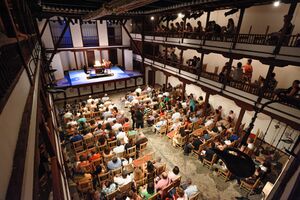Room for Everyone
The first commercial theatres
The Renaissance period is often associated with court theatres, but in the late 16th century commercial theatres made for large audiences were being built for the first time in London and Madrid, responding to the strong public desire to see plays.
The late renaissance period saw a flourishing of dramatic literature in Spain and Britain; the work of writers such as Sor Juana Inés de la Cruz, Miguel de Cervantes, Lope de Vega, William Shakespeare, Christopher Marlowe and Ben Jonson was immensely popular, and theatres were needed to meet that demand.
The first permanent venue in London designed specifically for theatrical productions was called simply The Theatre, built in 1576 (Q10092). It was followed by the Rose (1587, Q12550) and Swan (1596, Q8428) theatres, and then The Globe Theatre in 1599 (Q7846). These three theatres were built in an area called Bankside, on the south bank of the river Thames. Bankside was outside the jurisdiction of the City of London's civic authorities, so it became a place with less social regulation, where people would go for entertainment and relaxation.
The Globe was a circular building of 45m across, with an inner courtyard 30m in diameter. There were three floors for the public, which allowed a capacity of about 3,300 spectators (the reconstruction of 1997 only allows 1500 people, due to modern audience expectations and safety requirements). On one side, the rectangular stage, 13m x 18m, projected into the central space.
The three-storey structure established an audience hierarchy, although everyone entered through the same main entrance. The cheapest tickets, one penny, were the ones for the pit, representing more than half the capacity of the theatre, where spectators gathered standing next to each other. Here, the audience was without shelter, while the stage and wealthier spectators in the surrounding galleries were covered by thatch roofs.
The stage had three main parts: a front, unenclosed space thrusting out into the audience; a rear stage, separated from the front by a curtain; and a balcony or upper stage. The rear stage could be set with different props for different scenes and revealed by the curtain. The upper stage introduced the possibility to use height as part of the performance, as in the iconic balcony scene in Romeo and Juliet.
In Spain, the first public theatres were the Corral de Comedias – theatres built in the form of courtyards. The first of these was the Corral de la Cruz, Madrid, built in 1579 (Q13175), followed by the Corral del Príncipe in Madrid in 1583 (Q13175). The Corral de Comedias de Alcalá (Q8570) was built in 1601-02 by Francisco Sánchez, who bought a house and fenced off the back yard.
These theatres were arranged with the stage at one end of the courtyard and the audience around. Men of the common public watched the spectacle standing in the centre, while at the sides the balconies housed rooms for the nobility. Opposite the stage was another balcony: the upper floor for the clergy and the city’s notables. Below this was the women’s cazuela. A canopy across the courtyard provided shelter from the sun.
At the rear of the stage, the balconies were divided into niches that could be used for different stage effects. Their railings were removable to install elements such as city walls, stairs or towers. Each of these spaces was covered with curtains behind which small scenes could be prepared. As at the Globe, simple props worked with the so-called ‘spoken decoration’ in the play text and the audience’s imagination to create the scene.
Above the stage and the upper corridor, hidden by the canopy, was the attic where the stage machinery was housed. From here, elements such as clouds could be lowered. This attic also had a wooden floor with hatches, directly above the lower hatches in the galleries, to make room for the ropes from which the counterweights of the stage sets hung. The hatches both in the stage and in the niches of the galleries were usually connected with a lifting mechanism based on pulleys.
The only corral that has been completely preserved is the corral in Almagro (Q9440), where the International Festival of Classical Theatre is held annually.
The circular public theatres of London, and the courtyard Corrales in Spain, were amongst the first permanent, commercial theatres, and built on a tradition of performances on temporary stages in inn yards, dating back to the Middle Ages. They shared common features: they organised the audience in accordance with a social hierarchy, and they wrapped the audience around the stage to maximise audience capacity and so revenue. Both represented a radical shift from the court theatres. No longer was the building designed around the view of a single monarch looking at a perspectival, picture-frame stage – rather, the building was planned to accommodate the largest possible numbers of people from all parts of society.




